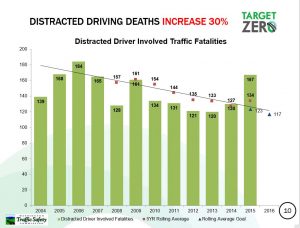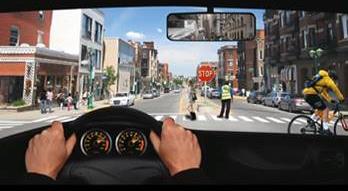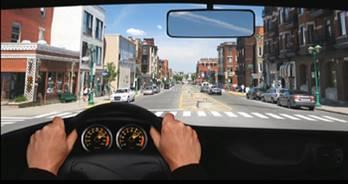In an extreme case of distracted driving last year, a man was caught on film operating a vehicle while simultaneously scanning an e-reader – and talking on the phone. As egregious as that example is, it’s nothing attorney Kathryn Potvin hasn’t heard before. “We’ve had crazy stories of someone practicing their flute at a stoplight or people reading the newspaper while they drive,” says Potvin, who represents collision victims at Putnam Lieb Potvin Dailey law firm.

Distracted driving is the cause of 30 percent of fatalities and 23 percent of serious injuries in crashes within the State of Washington, a statistic that has continued to rise in recent years. One in four crashes involve cell phone use just prior to the crash and researchers have found that driving while using your phone is the equivalent of having a blood-alcohol level of 1.9.
Potvin’s law firm is on the front line of the crisis, dealing frequently with the aftermath of serious accidents. “It keeps us busy in a way that we don’t want to be,” she says. “We see injuries that are career-ending and life-changing. Our role is to help someone who has been injured because someone else was careless and caused a collision. I would love to be able to direct my attention to other areas of helping people that don’t involve these types of severe injuries.”
Typically, people think of distracted driving as looking at your phone or texting, but in fact there are three types: visual, manual and cognitive. Visual distractions include everything from looking at a phone or reading a map to checking a mirror or turning to address a backseat passenger. Often, visual distractions also involve manual and cognitive ones. “We’ve even heard of people watching Netflix while driving,” says Potvin.
Manual distractions such as texting, eating, smoking, drinking, entering an address in a GPS device or even something as simple as putting on or removing sunglasses can create a dangerous moment of inattention.


And then there are cognitive distractions, currently a hot topic at legal conferences, according to Potvin. “Talking to someone, even through a hands-free device, distracts your brain from paying attention to the roadway,” she says. “Even though someone may be strictly complying with the letter of the law, they could still be distracting themselves.”
Without cameras actually in vehicles, it’s difficult to track exactly how many crashes are caused by such behaviors but Potvin estimates that the majority of cases that end up in her office involve distracted driving in one way or another. “Drivers don’t automatically ‘fess up to why they rear-ended someone or ran a red light, but it’s common sense that they weren’t paying attention for some reason,” she says. “Whether they were using an electronic device or adjusting vehicle controls like the climate of the car or the radio, eating or drinking in the car, managing an unrestrained pet, parenting kids who are fighting in the back, talking with friends, or simply thinking about something that happened earlier in the day, these are all variations of distracted driving.”

Once a collision has occurred, those drivers are not only held liable for any financial damage but may also face criminal charges based on traffic laws that prohibit negligent or reckless driving. Washington State has the toughest distracted driving laws in the nation. Drivers found guilty of using their cell phones – including holding their phones while driving – will receive a minimum $136 ticket for the first offense. Other types of activities like grooming, smoking or eating will result in a $99 fine, and all cell phone violations are reported to insurance companies.
The best way to comply with the law, at least in terms of cell phones, is by putting them away, says Potvin. “Generally speaking, we encourage people to turn their phones off. Don’t use them while you’re driving unless it’s an emergency or you absolutely need to. Very rarely is there something that can’t wait.”
Education is key to spreading awareness about the issue and some of the most effective campaigns address students well before they begin driving. “I’ve seen programs at the middle school level and even earlier that address the safe use of electronic devices and letting kids know that the driver’s job is to drive,” says Potvin. “I think the education they’re doing with students at a young age now is going to be really helpful in the future.”
Learn more by visiting the Putnam Lieb Potvin Dailey website or calling 360-754-7707.
Sponsored



















































